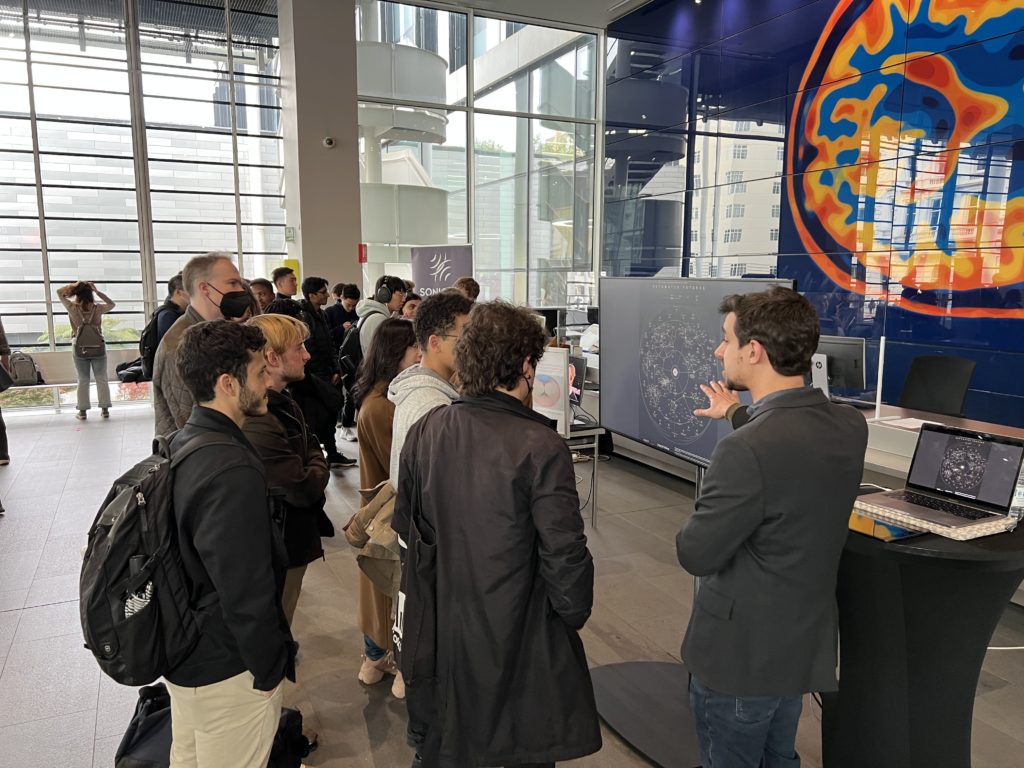Working again with Dr Antoine Cully, leader of the Adaptive and Intelligent Robotics Lab, who collaborated with us in the project, it was an exceptional evening of intense discussions and surprising insights.
It revealed to us how important and emotive the topic of Artificial Intelligence actually is – for diverse reasons – to a large variety of people.
Embracing chaos: Questions to engage with, answers to inspire
After two years of enforced online-led engagement, the College opened its doors for another Imperial Lates in-person event in late April. This one was centred on science fiction and whether technologies from our favourite films, comic strips and stories are likely to come to fruition.
The main entrance of the South Kensington campus was adorned with many stands curated by students and academics – and a DJ-ing C3PO. The stands covered topics ranging from the physics of lightsabers, the engineering challenges of The Matrix, the morality of human cyborgs with bionic limbs and computer-augmented brains.
A flock of people with many a variety of backgrounds and different curiosities about technology flooded the room with wonder, armed with questions regarding the future – and we were delighted to help them navigate the constellation of our Automated Futures.

Before we had time to set our map on the TV screen, Dr Cully was immediately questioned about the technicalities of deep neural networks and their difference with reinforced learning algorithms by a business consultant roaming around the map – the first of many valuable conversations about the relevance of emerging technologies in a variety of fields and sectors.
As more interested people showed up, the questions ranged from purely technical to philosophical speculations on the dangers of the rising of artificial consciousness. Alongside Dr Cully, Claudio Sanna from our team was able to field some of the discussion points, and the insights gained will help with shaping how we work with organisations to bring ideas to life for impact.
Some of the other questioners and their questions included:
- A masters student in educational sciences inquired over the possibility in the future to develop AI teachers to support autistic students having a hard time relating with human emotions.
- A project manager in the pharmaceutical industry, was amazed by the useful ordering quality of the map. He revealed his prior difficulties in making sense of the different branches of AI research and understanding what different methods can be applied in the various areas of his business – To him, the map was a much-needed tool to reduce the perceived complexity of the field, to navigate its state-of-the-art elements and consider its possible evolution.
- A clinical psychologist asked whether future people would prefer spending their life on the digital metaverse rather than in real life, in the likes of the movie “Ready player one”.
This last one kept Dr Cully entertained for about half an hour. He wisely responded that our technology is way far from offering virtual experiences that are comparable with physical ones and that we’ll probably never develop a system able to engage the totality of human senses. The digital, according to the professor, will always be just a supporting platform for the physical, not a substitute.
Thursday night takeaways: What did we learn?
Seeing so many people expressing their curiosity, confusion and fears around the future of artificial intelligence was a good gauge of the importance and relevance of our map. In fact it was realised exactly for this reason, as a visual platform or “ark” from which to navigate the waters of chaos surrounding the field.
Our aim from the outset was to provide a starting point for exploration and for speculation, to aid partners to identify opportunities in their areas, and discerning which specific branch(es) of AI might be best suitable for their business needs.
We left the event with a renewed perception of the importance of the map for people and its potential to stimulate discussion and unlock understanding. The breadth of interested audience member occupations, from students to business consultants, proved its value as a communications tool and stepping off point for individuals and businesses alike.
The event was a great preparation for our next showcase event for the map – more on this in a future blog, as well as updates from our Twitter channel.
Interested in knowing more about the future of AI and what it might mean to you organisation?
Download the map and the speculative dictionary here or get in touch to explore potential collaborations with us and our academics.